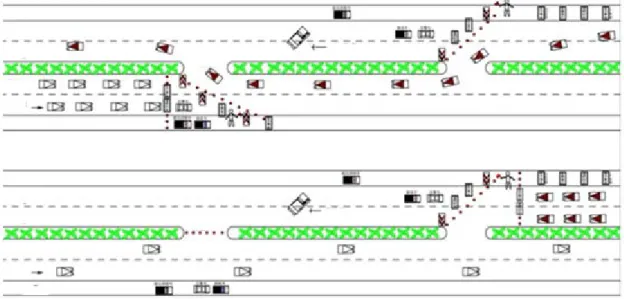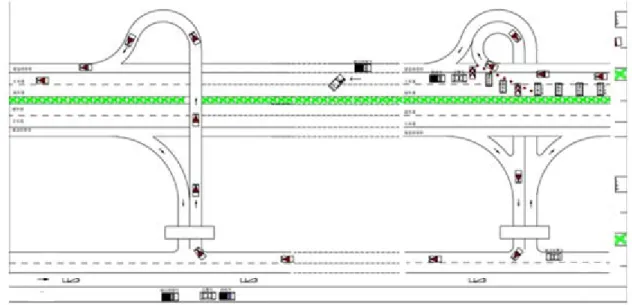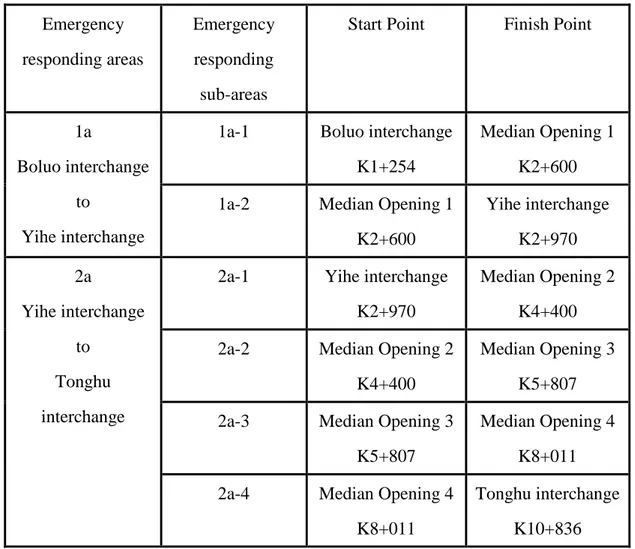METHODS OF EMERGENCY TRAFFIC ORGANIZATION, TAKING BOSHEN HIGHWAY AS AN EXAMPLE
Pengpeng Jiang
Research Institute of Highway, Ministry of Transport, China No. 8 Xitucheng, Beijing, China
0086-010-82019508 E-mail: pp.jiang@rioh.cn
Zicheng Zhao
Highway Construction Co., Ltd. Guangdong
F53, Litong Square, No. 32 Zhujiang East Road, Guangzhou, China 0086-020-29005362
E-mail: chinazzc@163.com Chunsheng Zhang
Boda Highway Co., Ltd. Guangdong, Boshen Branch Luoyang County, Boluo town, Huizhou, China
0086-752-6380088 E-mail: cauzcs@163.com
ABSTRACT
Emergency traffic organization under the circumstances of incidents is a very important technical aspect in incident management. It accelerates the speed of the highway administration department responding to a critical situation. It requires a good understanding of highway topology and incident situations. A good choice of traffic organization could result in saving many peoples’ lives.
In this paper, methods of emergency traffic organization under the circumstances of incidents are studied. The demonstration includes the dividing of emergency responding areas and incident areas. The combine traffic organization for the Up-flow area and incident area in the case of completely interrupted flow or incompletely interrupted flow is described. In the end, Boshen Highway is used as an example to demonstrate how to apply these methods in the real practice.
1 INTRODUCTION
With the development of regional logistic and regional communication, highway network plays a more and more important role in people’s daily life. A key concept of highway is to keep a constant and smooth traffic flow all the time. However the traffic flow on the highway is sometimes affected by traffic incidents. These traffic incidents include traffic accidents, vehicle failures, highway structural damages, code- red weather condition and so on. In the event of these kinds of emergency conditions, it is vital to set up some ways of traffic organization, in order to keep the traffic flowing, so that the injured people could be sent to the hospitals from the incident scenes, and the traffic delay around the incident points would not exceed the peoples’ tolerance.
Emergency traffic organization under the circumstances of incidents is a very important technical aspect in incident management. It accelerates the speed of the highway administration department responding to a critical situation. It requires a good understanding of highway topology and incident situations. A good choice of traffic organization could result in saving many peoples’ lives.
In this paper, methods of emergency traffic organization under the circumstances of incidents are first described. Then a practical example in Boshen highway is demonstrated to show how to apply these methods in real-life highway incident management.
2 THE DEFINITION OF EMERGENCY RESPONDING AREAS AND
INCIDENT AREAS
Traffic incidents might happen in any part of the whole highway. The purpose of setting up these “emergency responding areas” and “incident areas” is to make customized traffic organization plans possible for incidents in any part of the highway. The dividing of these emergency responding areas should take the highway topology into consideration, for example, the locations of median openings and interchanges. There will be customized traffic organization plans for every emergency responding area. Therefore in case of an emergency, the respond would be fast without taking any further decision process, as the emergency plans have already been prepared in advance.
2.1 The definition of emergency responding areas.
Interchanges are very useful in emergency traffic organizations. It can keep the incoming traffic flows out of the incident areas. The areas between two near interchanges are defined as emergency responding areas.
In the areas between two interchanges there are usually some median openings. These median openings are closed in normal daily highway operations. In the case of an emergency, these median openings could be open for traffic evacuations. The areas between the interchange and the nearest median opening, as well as the areas between two near median openings are
defined as emergency responding sub-areas. The definition of emergency responding areas and sub-areas are shown in the figure below.
Figure 1: The definition of emergency responding areas and sub-areas
2.2 The definition of incident areas.
The road section in the up-flow of the incident can be divided into two areas: Incident areas and Up-flow areas. The area from the incident point to the first available evacuation point is defined as Incident area. The evacuation points can be interchanges (toll stations) and median openings. The area in the up-flow direction of the first available evacuation point is defined as Up-flow area. The figure below shows the definition of these two concepts.
Figure 2: Definition of Incident area and Up-flow area
In the figure above, the red tangle marks the incident point; the blue tangle marks the first available evacuation point in the up-flow direction of the incident. In this case, it is a median opening. Thus, the yellow-highlighted band is the Incident area; the blue-highlighted band is the Up-flow area. In most cases the methods of emergency traffic organization used in these two areas are different, thus these two areas should be considered separately.
3 METHODS OF EMERGENCY TRAFFIC ORGANIZATION
Traffic incidents could result in traffic flows completely interrupted or incompletely interrupted. Thus the traffic organizations of both the Incident area and Up-flow area should consider these two scenarios. All of these scenarios will be discussed below.
3.1 Traffic organization for the Up-flow area in the case of completely
interrupted
When the incident causes the one-direction traffic flow completely interrupted, the following plans of emergency traffic organization could be applied. The choice of plans is highly related to the incident location and traffic volume at the moment of incident.
3.1.1 Use the opposite lanes for traffic organization, one flow of one direction at a time
This method requires the usage of the opposite lanes for traffic organization. First, the traffic flow of the original direction uses all the lanes for a while, and then the flow of this direction is stopped. The interrupted traffic flow uses the median opening to get to these opposite lanes, continue to the next median opening, so as to drive pass the incident point. This marks a circle of this plan. Then the evacuating traffic flow is stopped, the flow of the original direction is allowed to continue. The circle should be repeated until the incident is cleared. The duration for the flows of each direction can be adjusted by the working crew at the site, according to the traffic volumes of both directions.
Figure 3: Use the opposite lanes for traffic organization, one flow of one direction at a time This plan has a low risk, as only one way traffic will be on the lanes each time. But it requires time to completely empty the vehicles in the section to ensure the safety. This plan is suitable for the situations that the traffic volumes of both directions are small, or one way large yet one way small. It is not suitable for large traffic volumes of both directions.
3.1.2 Use the opposite lanes for traffic organization, two ways of traffic at the same time
This method requires the usage of the opposite lanes for traffic organization. Different to 3.1.1, this plan allows two ways of traffic using the lanes at the same time. The lanes of the opposite direction are divided for two-way traffic. The vehicles of the incident direction drive pass the median opening to the opposite lanes then to the next median opening, so as to pass the incident point.
Figure 4: Use the opposite lanes for traffic organization, two ways of traffic at the same time This plan ensures the continuality of both ways of traffic. It requires the placement of dividing signs on the opposite lanes to remind and guide the drivers. This plan has some potential risks, the driving speed in the area should be strictly controlled. This plan is suitable for the situation that the traffic volume of the opposite direction is relatively small.
3.1.3 Use the median opening to make a U-turn, then continue on the opposite lanes to leave the highway
This plan guides the vehicle to use the nearest median opening to make a U-turn then continue on the opposite lanes to leave the highway at the nearest interchange. The vehicles would then have to use the local road network to drive to the next interchange, get on the highway again, then to reach their destinations.
Figure 5: Use the median opening to make a U-turn, continue on the opposite lanes to leave the highway
This plan causes little influence to the opposite traffic flows. As there is no two way traffic using one way lanes, the risk is low. However, this plan changes the driving direction of the
vehicles in the up-flow area of the incidents. These vehicles have to get off the highway first, and then use the local road to the next interchange of their driving direction. It increases the driving distances and the drivers might be lost in the local road network, if they are not familiar with the local road network. And for some large freight vehicles it is difficult to make a U-turn in the median opening, which will cost more time for the evacuation. This plan is suitable for the situations that the incident point and the median opening used for evacuation are close to an interchange, and for the situations that two near median openings are very far away.
3.1.4 Use the interchange to keep the incoming traffic flows out of the incident area
This plan uses the interchange exits (toll stations) to guide the incoming vehicles to the local road network. Then the vehicles will enter the highway again in the next interchange of their original driving direction, so the pass of the incident point is avoided.
Figure 6: Use the interchange to keep the incoming traffic flows out of the incident area The efficiency of this plan is high, for it has no influence on the opposite traffic. Thus it is safe. But the driving distances of the evacuated vehicles are increased, as the local road network is used. This plan is suitable for the evacuation of serious incidents, as it would take longer time to clear the incidents.
3.1.5 The combine use of different plans
When deciding which plan to be used for emergency traffic organization, the traffic volume, the time length of the incident, the location of the incident and whether certain plan could be realized or not should be considered. Sometimes more than one plans are used. For example, 3.1.3 and 3.1.4 could be applied for vehicles in different areas at the same time.
3.2 Traffic organization for the Up-flow area in the case of incompletely
interrupted
When the incident causes the incompletely interrupted of flow for one direction, one or more of the lanes in this direction is usable.
3.2.1 3.2.1 The remaining capacity is enough for the traffic demand
When the remaining capacity is enough for the traffic demand, the lanes of the incident should be separated by warning signs and closed for vehicles. The vehicles could drive pass the incident point at a reduced speed.
Figure 7: The separation of the closed lane by warning signs
3.2.2 The remaining capacity is not enough for the traffic demand
For the vehicles in the nearest interchange, plan 3.1.4 should be applied. For the vehicles that already pass the nearest interchange, plan 3.1.2, 3.1.3 and 3.2.1 should be applied.
3.3 Traffic organization for the incident area
The discussion of traffic organization for the incident area is focus on the situation that the incident causes the traffic flow completely interrupted. In case of incompletely interrupted, the vehicles in the incident area could be evacuated in a short time by the plan 3.2.1. When the incident causes the traffic flow completely interrupted, the following plans could be applied.
3.3.1 Turn around and use the opposite lanes to exit the highway
The vehicles in incident areas turn around, guided by traffic police. Then these vehicles drive through the nearest median opening to the opposite lanes to exit the highway, use the local road network to the next interchange to enter the highway again.
Fugure 8: Turn around and use the opposite lanes to exit the highway
This plan is suitable for the situation that the incident location is near the interchange. This plan is often combined with 3.1.3
3.3.2 Turn around and continue in the original direction on the opposite lanes
The vehicles in incident areas turn around, guided by traffic police. Then these vehicles drive through the nearest median opening to the opposite lanes, continue to drive in the original direction until the next median opening, so as to avoid the incident point.
This plan is often combined with 3.1.1 or .3.1.2
Figure 9: Turn around and continue in the original direction on the opposite lanes
3.3.3 turn around and use the current lanes to exit the highway
When the median opening is not available between the incident point and the up-flow interchange, this plan could be implemented. The vehicles in incident areas turn around, guided by traffic police. Then these vehicles continue on the current lanes to exit the highway, use the local road network to the next interchange to enter the highway again.
This plan is suitable for the situation that the incident point is near the interchange. It is often combined with plan 3.1.4.
Figure 10: Turn around and use the current lanes to exit the highway
4 THE PRINCIPLES OF CHOOSING EMERGENCY TRAFFIC
ORGANIZATION PLANS
The incident could happen in any part of the highway, the traffic volumes at that moment may be vary from time to time. Some principles should be set up to be the guidelines of choosing emergency traffic organization plans in real-life application.
(1) Consider the availability of interchanges and median openings near the incident point. (2) Consider the influence of the plans on the normal traffic, mostly the opposite traffic (3)Consider the potential risk of the plans, especially for the plans that will induce two-way traffic on one-way lanes
(4)Consider the convenience of the execution of the plans.
(5)The priority is not to change the driving direction of the vehicles. Only when the vehicles have to drive through a tunnel on the opposite lanes, should the driving direction be changed.
According to the rules mentioned above, the combined emergency traffic organization plans for Incident area and Up-flow area is listed below
Table 1: The combined emergency traffic organization plans for Incident area and Up-flow area
No.
Incident influence
Plans for Incident area
Plans for Up-flow area
1 completely interrupted 3.3.2 3.1.2; 3.1.4 2 3.3.2 3.1.1; 3.1.4 3 3.3.1 3.1.3; 3.1.4 4 3.3.3 3.1.4 5 incompletely interrupted 3.2.1 3.1.4; 3.1.2/ 3.1.3 6 3.2.1 3.1.2/ 3.1.3
5 PRACTICE OF EMERGENCY TRAFFIC ORGANIZATION IN BOSHEN
HIGHWAY
Boshen Highway is a newly-constructed highway from Boluo to Shenzhen in Guangdong Province, China. It is using the methods mentioned above to set up an emergency solution for traffic organization. There are nine interchanges on this highway. The emergency responding areas and sub-areas should be divided as follows. Only a part of the highway is shown in the table as an example in this paper.
Table 2: The dividing of the emergency responding areas and sub-areas Emergency
responding areas
Emergency responding sub-areas
Start Point Finish Point
1a
Boluo interchange to
Yihe interchange
1a-1 Boluo interchange K1+254
Median Opening 1 K2+600 1a-2 Median Opening 1
K2+600 Yihe interchange K2+970 2a Yihe interchange to Tonghu interchange
2a-1 Yihe interchange K2+970
Median Opening 2 K4+400 2a-2 Median Opening 2
K4+400
Median Opening 3 K5+807 2a-3 Median Opening 3
K5+807
Median Opening 4 K8+011 2a-4 Median Opening 4
K8+011
Tonghu interchange K10+836
In this table, “a” means driving direction is from north to south.
The solutions for the incident happening in each sub-area are listed in the following table. The solutions are adjusted according to the topology of the sub-areas.
Table 3: Solutions for the Sub-areas
Sub-area Incident influence Incident area Up flow area Figure
1a-1 completely interrupted 3.3.3 3.1.4 Figure11
incompletely interrupted 3.2.1 3.1.4
1a-2 incompletely interrupted 3.3.2 3.1.1; 3.1.4 Figure12 3.1.2; 3.1.4
completely interrupted 3.2.1 3.1.4; 3.1.2
Figures are made to demonstrate the solutions. At this point, the emergency solution for traffic organization is completed. Incidents happen in any part of the highway will have a quick solution.
6 CONCLUSION
In this paper, methods of emergency traffic organization under the circumstances of incidents are introduced. The demonstration includes the dividing of emergency responding areas and incident areas. The combine traffic organization for the Up-flow area and incident area in the case of completely interrupted flow or incompletely interrupted flow is described. In the end, Boshen Highway is used as an example to demonstrate how to apply these methods in the practice.
REFERENCES
Farazmand Ali (2001).Handbook of Crisis and Emergency Management, Marcel Dekker,Inc. pp16-18
Liu Xiao-ming, Hu Hong.(2008). Research status and prospect of emergency transportation evacuation, Journal of Traffic and Transportation Engineering Mou Zhenhua (2009). Study on Emergency Traffic Organization of Urban Road
Traffic System under Abnormal State, Management and Service Science. Paolo Dell Olmo,Pitu B.Mirchandani.REALBAND (1999). :An Approach for
Real-Time Coordination of Traffic Flows on Networks, Transportation Research Record. pp 106~116
Peng,Gongquan (2008). Research on responding plans for incidents on the highway, 2008
Suleyman Tufekci,William A Wallace (1998). The emerging area of emergency management and engineering, IEEE Transactions on engineering management, pp.67-93
Boluo
Interchange interchangeYihe
Exit Exit 1a-1 1a-2 1b-1 1b-2 × × × K1+254 K2+600 K2+970
Figure 11: Emergency solution for traffic organization when incident happens in sub-area 1a-1
Boluo
Interchange InterchangeYihe
1a-1 1a-2 1b-1 1b-2 × × × K1+254 K2+600 K2+970









